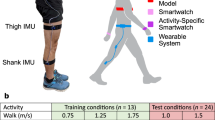Abstract
Weight training, in addition to aerobic exercises, is an important component of a balanced exercise program. However, mechanisms for tracking free weight exercises have not yet been explored. In this paper, we study methods that automatically recognize what type of exercise you are doing and how many repetitions you have done so far. We incorporated a three-axis accelerometer into a workout glove to track hand movements and put another accelerometer on a user’s waist to track body posture. To recognize types of exercises, we tried two methods: a Naïve Bayes Classifier and Hidden Markov Models. To count repetitions developed and tested two algorithms: a peak counting algorithm and a method using the Viterbi algorithm with a Hidden Markov Model. Our experimental results showed overall recognition accuracy of around 90% over nine different exercises, and overall miscount rate of around 5%. We believe that the promising results will potentially contribute to the vision of a digital personal trainer, create a new experience for exercising, and enable physical and psychological well-being.
Preview
Unable to display preview. Download preview PDF.
Similar content being viewed by others
References
Ades, P.A.: Cardiac rehabilitation and secondary prevention of coronary heart disease. The New England journal of medicine 111, 369–376 (2001)
Shephard, R.J., Balady, G.J.: Exercise as Cardiovascular Therapy. Circulation, New York 99, 963–972 (1999)
Sothern, M.S., Loftin, M., Suskind, R.M., Udall, J.N., Blecker, U.: The health benefits of physical activity in children and adolescents: implications for chronic disease prevention. European Journal of Pediatrics 158(4), 271–274 (1999)
Dishman, E.: Inventing wellness systems for aging in place. IEEE Computer 37, 34–41 (2004)
Healey, J., Logan, B.: Wearable Wellness Monitoring Using ECG and Accelerometer Data. HP Laboratory Tech Report, HPL-2005-134 (July 2005)
The President’s Council on Physical Fitness and Sports. Fitness fundamentals guidelines for personal exercise programs. online council publications (2003), http://www.fitness.gov/fitness.htm
FitLinxx, http://www.fitlinxx.com/brand.htm
Apple – Nike + iPod, http://www.apple.com/ipod/nike/
Intille, S.S.: Designing a home of the future. IEEE Pervasive Computing 1(2), 76–82 (2002)
DeVaul, R., Sung, M., Gips, J., Pentland, A.S.: MIThril 2003: Applications and Architecture. In: Proceedings of the 7th IEEE International Symposium on Wearable Computers, October 2005, pp. 4–11. IEEE Computer Society Press, Los Alamitos (2005)
Bao, L., Intille, S.S.: Activity recognition from user-annotated acceleration data. In: Ferscha, A., Mattern, F. (eds.) PERVASIVE 2004. LNCS, vol. 3001, pp. 1–17. Springer, Heidelberg (2004)
Minnen, D., Starner, T., Essa, I., Isbel, C.: Discovering Characteristics Actions from On-Body Sensor Data. In: Int. Symp. On Wearable Computing (ISWC), Montreux, CH, October 2006, pp. 11–18 (2006)
Ward, J.A., Lukowicz, P., Tröster, G.: Gesture spotting using wrist worn microphone and 3-axis accelerometer. In: Proceedings of the 2005 joint conference on Smart objects and ambient intelligence: innovative context-aware services: usages and technologies, vol. 121, pp. 99–104 (2005)
Westeyn, T., Brashear, H., Atrash, A., Starner, T.: Georgia Tech Gesture Toolkit: Supporting Experiments in Gesture Recognition. In: Proceedings of International Conference on Perceptive and Multimodal User Interfaces 2003, pp. 85–92 (2003)
Benbasat, A.Y., Paradiso, J.A.: An Inertial Measurement Framework for Gesture Recognition and Applications. In: Wachsmuth, I., Sowa, T. (eds.) GW 2001. LNCS (LNAI), vol. 2298, pp. 9–20. Springer, Heidelberg (2002)
Wyatt, D., Philipose, M., Chouhury, T.: Unsupervised Activity Recognition using Automatically Mined Common Sense. In: Proceeding of the Twentieth National Conference on Artificial Intelligience, AAAI 2005, Pittsburg, PA, July 2005, pp. 21–27.
Hamid, R., Maddi, S., Johnson, A., Bobick, A., Essa, I., Isbell, C.: Discovery and Characterization of Activities from Event-Streams. In: Proceedings of UAI 2005, Edinburgh, Scotland, pp. 71–78 (2006)
Lester, J., Choudhury, T., Kern, N., Borriello, G., Hannaford., B.: A Hybrid Discriminative –Generative Approach for Modeling Human Activities. In: Proceedings of International Joint Conference on Artificial Intelligence, IJCAI 2005, July 2005, pp. 766–772 (2005)
Subramanya, A., Raj, A., Blimes, J., Fox, D.: Recognizing Activities and Spatial Context Using Wearable Sensors. In: Proceedings of the 22nd Annual Conference on Uncertainty in Artificial Intelligence (2006)
Delavier, F.: Strength Training Anatomy, 2nd edn. Human Kinetics Publishers (2005)
Cane, J., Glickman, J., Johnson-Cane, D.: Complete Idiot’s Guide to Weight Training. Alpha Books (1999)
Spark Fun Electronics, http://www.sparkfun.com/
Benbasat, A.Y.: An Inertial Measurement Unit for User Interfaces, Master Thesis, MIT Media Lab (September 2000)
Philipose, M., Fishkin, K.P., Perkowitz, M., Patterson, D.J., Fox, D., Kautz, H., Hähnel, D.: Inferring Activities from Interactions with Objects. IEEE Pervasive Computing 3(4), 50–57 (2004)
Murphy, K.P.: The Bayes net toolbox for MATLAB. Technical report 94720-1776, Dept. Comp. Sci., University of California at Berkeley, Berkeley, CA (2001)
Murphy, K.P.: Hidden Markov Model (HMM) Toolbox for Matlab, http://www.cs.ubc.ca/~murphyk/Softwared/HMM/hmm.html
Hartmann, B., Abdulla, L., Mittal, M., Klemmer, S.R.: Authoring sensor-based interactions by demonstration with direct manipulation and pattern recognition. In: Proceedings of ACM CHI 2007 Conference on Human Factors in Computing Systems, CHI 2007, pp. 145–154. ACM Press, New York (2007)
Forney, G.D.: The Viterbi algorithm. Proceedings of IEEE 61(3), 268–278 (1973)
Programs for Digital Signal Processing. Algorithm 5.2. IEEE Press, New York (1979)
Lenenshtein, V.I.: Efficient reconstruction of sequences from their subsequences or super sequences. J. Comb. Theory Ser. A 93(2), 310–332 (2001)
Author information
Authors and Affiliations
Editor information
Rights and permissions
Copyright information
© 2007 Springer-Verlag Berlin Heidelberg
About this paper
Cite this paper
Chang, Kh., Chen, M.Y., Canny, J. (2007). Tracking Free-Weight Exercises. In: Krumm, J., Abowd, G.D., Seneviratne, A., Strang, T. (eds) UbiComp 2007: Ubiquitous Computing. UbiComp 2007. Lecture Notes in Computer Science, vol 4717. Springer, Berlin, Heidelberg. https://doi.org/10.1007/978-3-540-74853-3_2
Download citation
DOI: https://doi.org/10.1007/978-3-540-74853-3_2
Publisher Name: Springer, Berlin, Heidelberg
Print ISBN: 978-3-540-74852-6
Online ISBN: 978-3-540-74853-3
eBook Packages: Computer ScienceComputer Science (R0)




